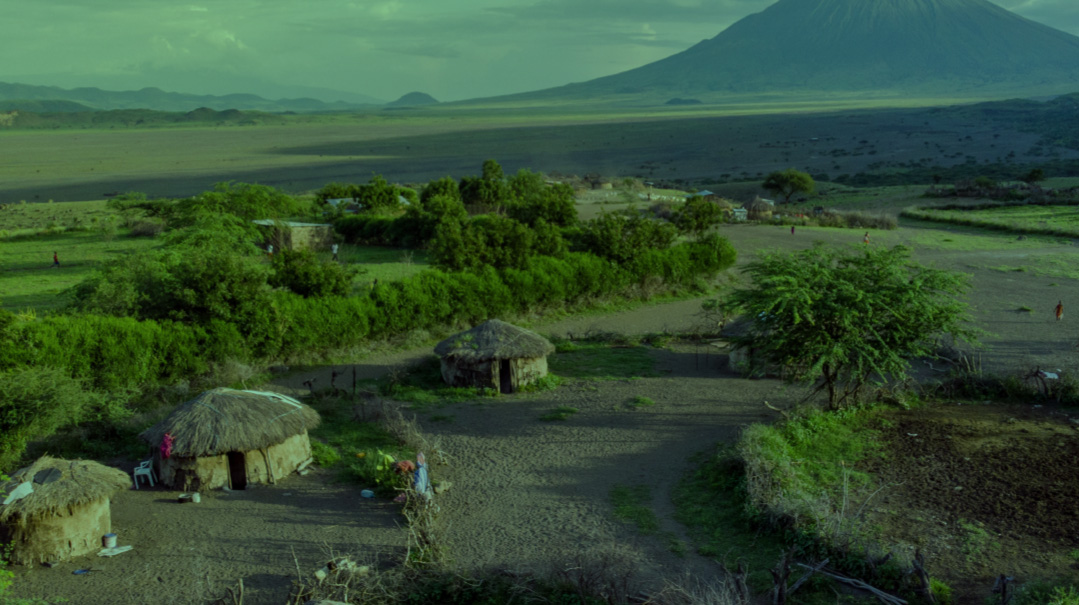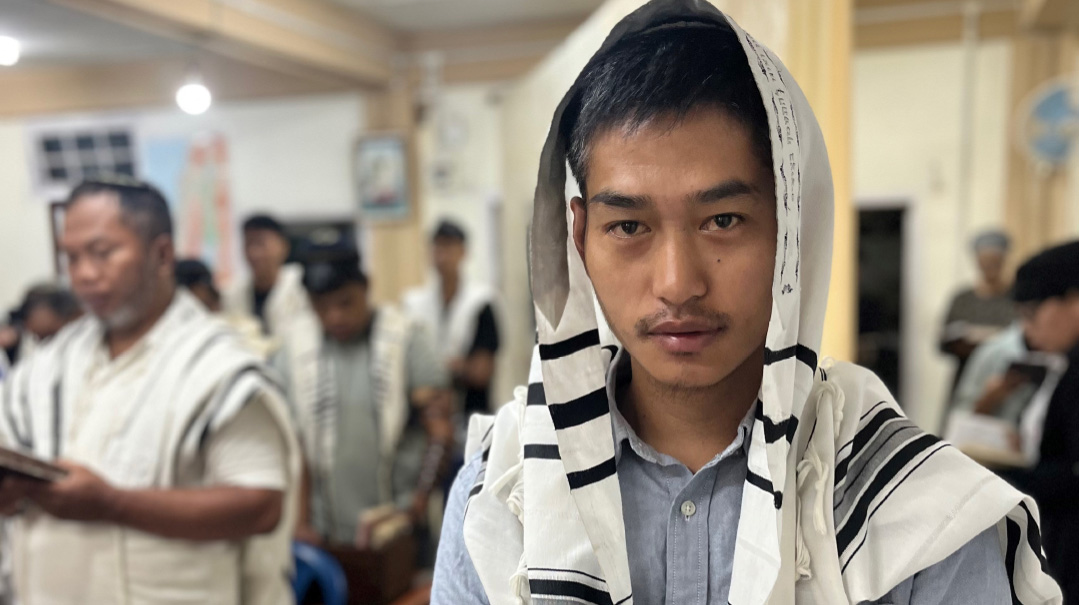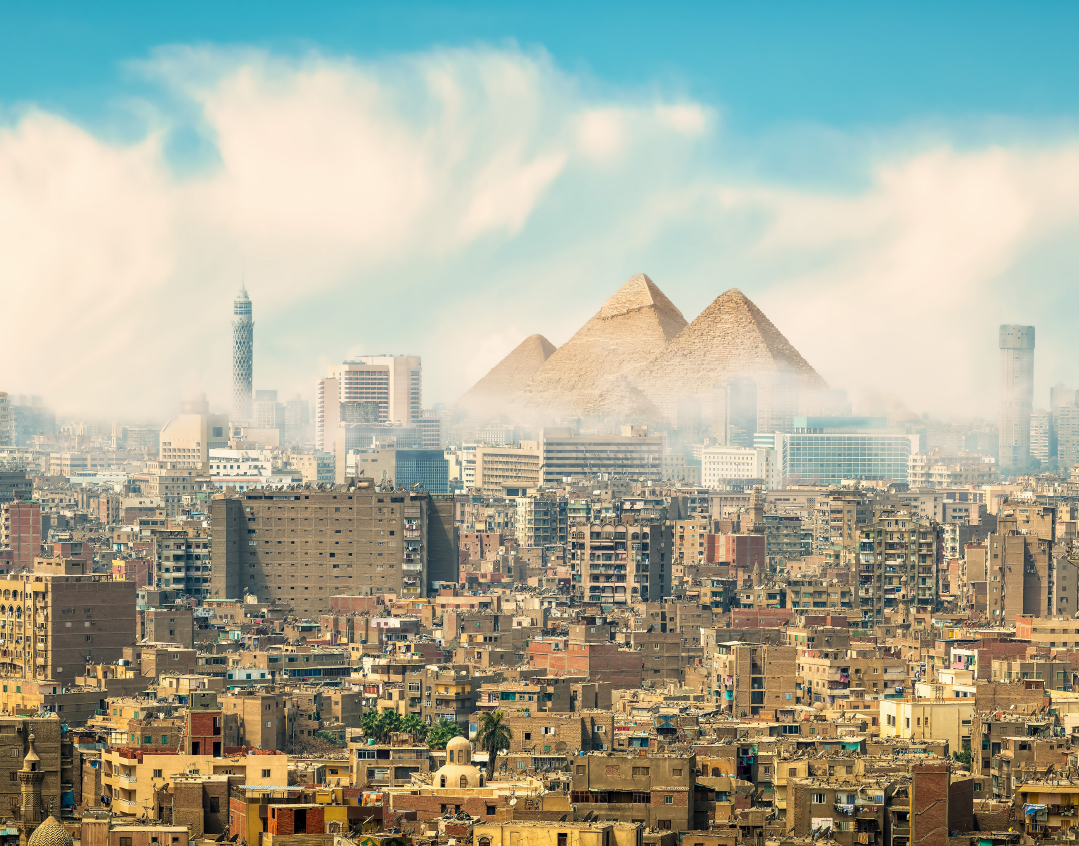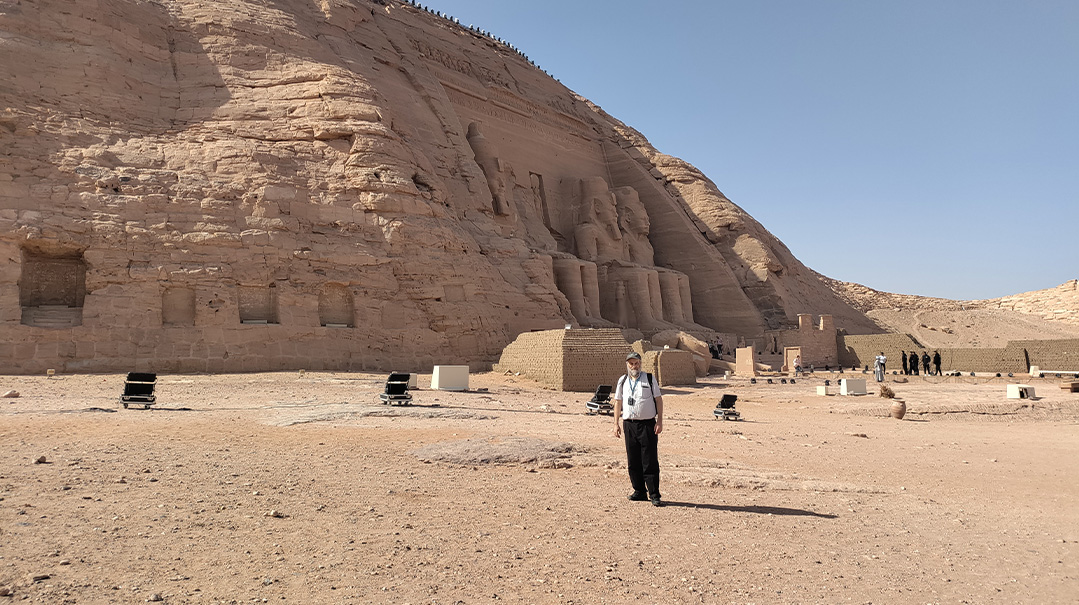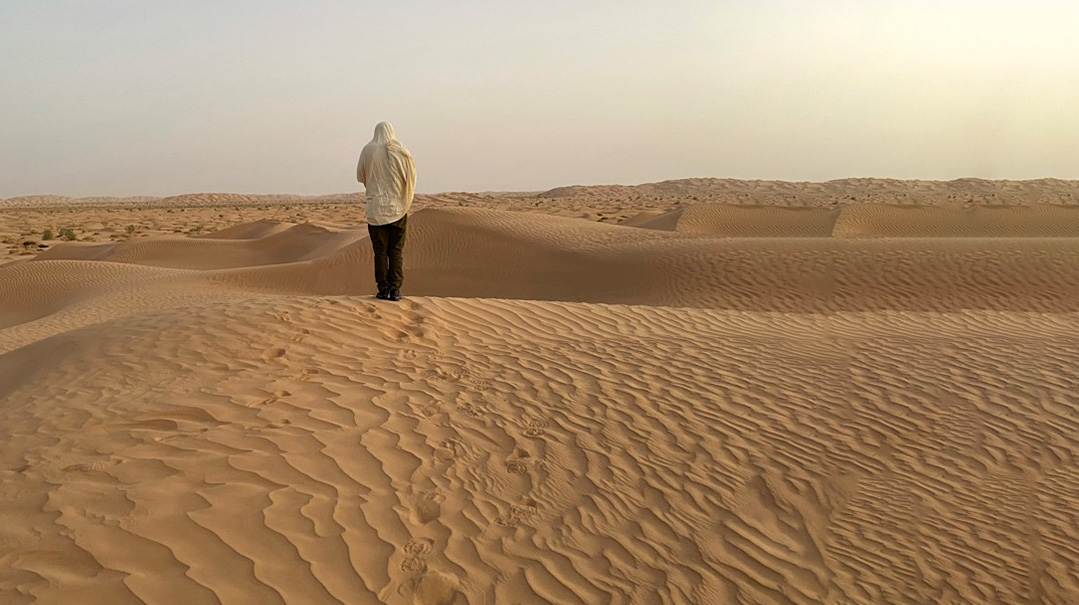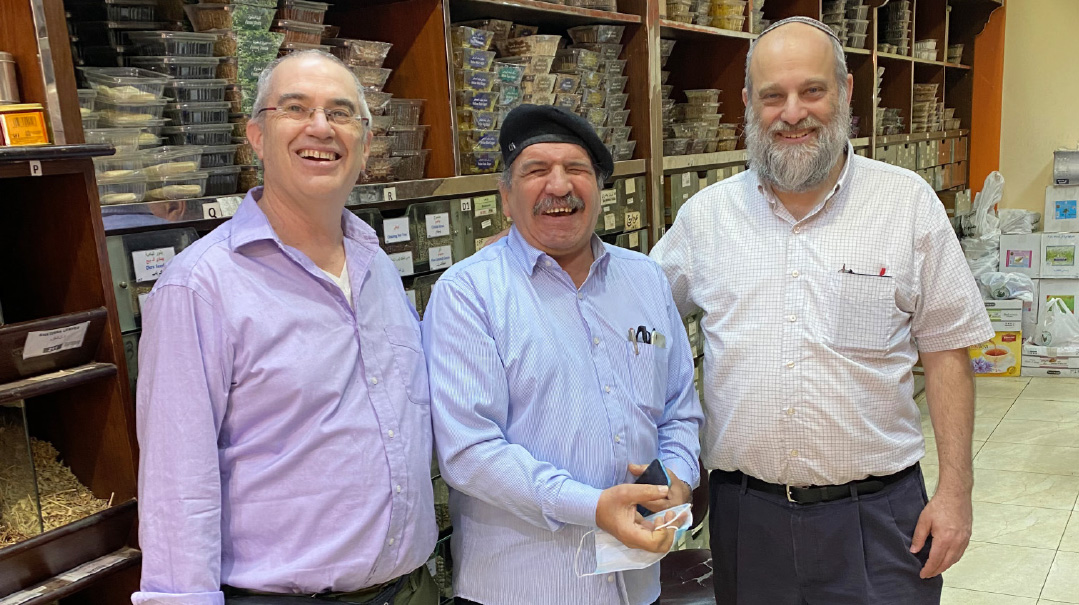Royal Welcome
| September 13, 2022Ari and Ari visit the Jews of Scotland
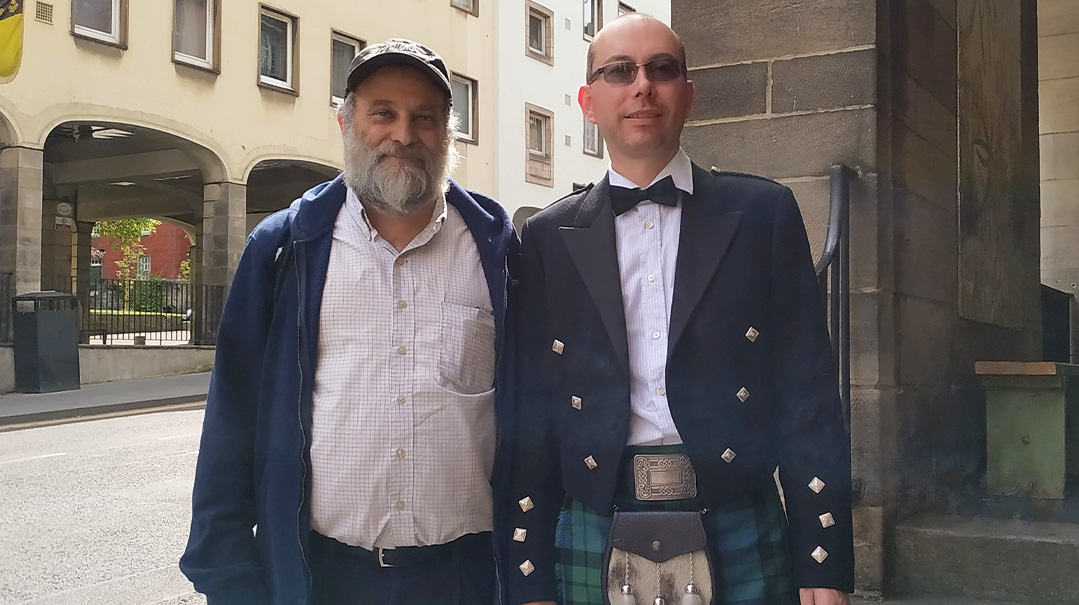
Text and photos by Ari Z. Zivotofsky and Ari Greenspan
It’s not quite as northern as the “land of the midnight sun,” but even though the days in Scotland are quite long, the sun has not yet set on the Scottish Jewish community. While many people believe the main reason to visit Scotland is to take whisky tours (and indeed they put it everywhere for tourists, even in ice cream and hand soap), we were there to meet the Jews of Scotland and learn about their history.
Scotland is physically and governmentally a part of the United Kingdom (although with its own devolved parliament that deals with health, education, and several other issues independently), and while the Scottish Jewish community does have connections to other UK communities, it very much has its own history and identity.
Today, there are today two main centers of active Jewish life, located in Scotland’s two largest cities, Glasgow and Edinburgh. These two communities are quite intertwined, despite the sentiment among the general population in Glasgow, related to us by several taxi drivers, that “the best thing to come out of Edinburgh is the train to Glasgow.” (Although to be honest, speaking to the locals, with their trademark Brogue accents, was often a challenge. In fact, poskim have even taken note — a teshuvah of the Minchas Yitzchak (3:120) states that in Scotland, names in a get should be written in accordance with their unique pronunciation.)
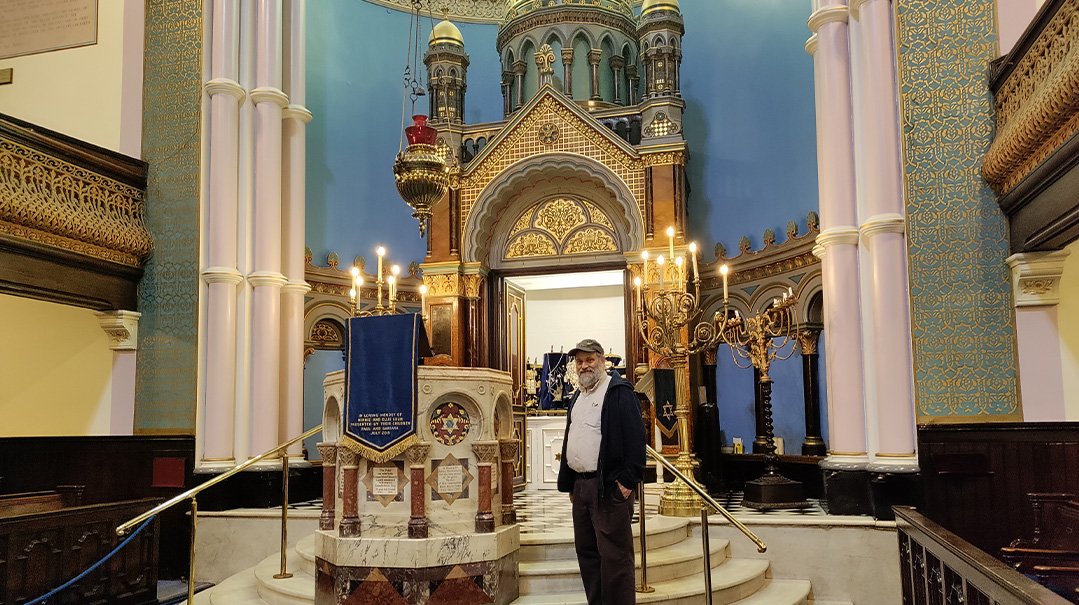
Sense of Community
While the Jewish population is in decline, there are still approximately 5,500 Jews in Scotland, about 4,000 of them in Glasgow. Organized Jewish life didn’t begin until the early 19th century, but there might have been some Jews in Scotland hundreds of years earlier: As early as 1180, the bishop of Glasgow warned Christians about borrowing money from Jews. Throughout the early 19th century, a trickle of Jews looking to escape pogroms in Eastern Europe settled in Glasgow, and by the 1870s, with around 1,000 Jews in the city, the community made plans to build a shul building. The site they chose at the corner of Garnet and Hill Streets gave the name to the shul that still stands at that location: the Garnethill Synagogue. This was in an affluent area that today is in the heart of downtown Glasgow. The magnificent Victorian-style synagogue was officially opened in 1879 by Rabbi Hermann Adler, who would later become chief rabbi of the British Empire. (The shul was extensively renovated in 1998 and rededicated by Chief Rabbi Lord Jonathan Sacks.)
The impressive shul has elements of Moorish, Romanesque, and Gothic styles, with intricate huge stained-glass windows in the 500-seater main sanctuary, an eight-foot-wide main entrance doorway, huge plaques with special prayers for the Royal family and for the State of Israel, and an ornate entranceway that includes memorials to community World War I vets and to the over 80 members who lost their lives fighting the Nazis between 1939 and 1945.
There is a balcony for women and an area in the back balcony for the choir, but with today’s smaller turnout, the balcony is no longer used. The Garnethill Synagogue still has a minyan on Shabbos morning, but during the week functions more as a museum and educational center, and even conducts tours for non-Jewish school groups. The Garnethill Synagogue now also houses a Jewish heritage center and the Scotland Jewish archives, but even as it was being refurbished to serve those additional functions, it was done in a way to allow the edifice to continue functioning as a shul. A display featuring some prominent Scottish Jews includes a few interesting characters such as Isaac Cohen, a hat maker who arrived in 1812 and is credited with introducing the silk hat to Scotland; Abraham Harris, a tobacconist from Suwalki, Poland, who arrived in 1881; and David Heilbron, an extremely successful wine merchant who arrived from the Netherlands about 1870.
We were aware of the research of foremost Scottish Jewry historian Dr. Kenneth Collins, a Scottish-born physician now living in Jerusalem, but we were awed by the vast number of articles and books he’s written on every aspect of Scottish Jewish history. The resident archivist pulled up fascinating documents for us, including records of the Glasgow shechitah society from 100 years ago, and databases of all 17 Jewish cemeteries in Scotland and of almost 40,000 Scottish Jews.
The locus of the Jewish community, however, is today no longer centered around the Garnethill area, but has moved to the southern suburbs. There are now two remaining active Orthodox shuls that are in the process of merging, the Giffnock Synagogue and the Newton Mearns Synagogue. Our first morning, we made our way to the Giffnock Synagogue in the drizzle and indeed found the northernmost British daily minyan, not a large crowd, but one made of regulars who clearly have a sense of camaraderie and community. Over the week, we felt we became part of the crowd, and it was nice to see different faces at different minyanim.
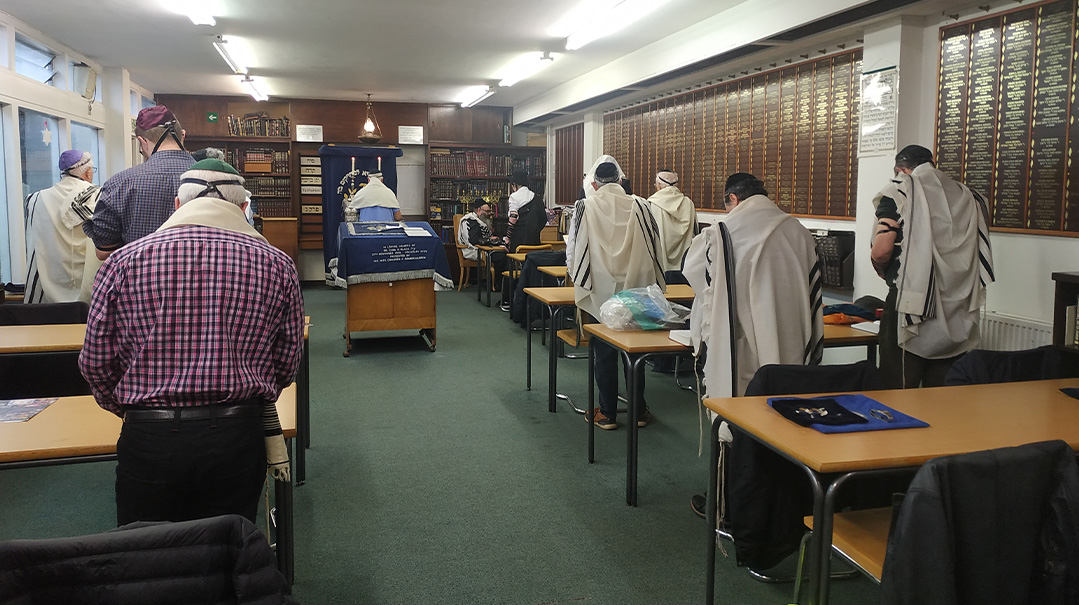
As the locus of the Jewish community has shifted, the majestic Garnethill Synagogue serves mostly as a museum and education center, while the daily minyanim are in the two Orthodox shuls in the southern suburbs
Secrets in the Attic
Scotland is proud of its cultural history of poets, philosophers, scientists, authors, and artists. Not far from Garnethill synagogue is one of its most famous museums, Kelvingrove Art Gallery and Museum, but more than exhibits of ancient Egyptian artifacts or taxidermied wildlife, we were especially interested in the Marianne Grant exhibit. Marianne Grant was born in Prague in 1921. At the beginning of World War II, she and her mother were sent first to Theresienstadt and then to Auschwitz-Birkenau. She was a talented artist who survived by drawing pictures for Mengele and other SS guards. She moved to Glasgow in 1951 where her husband was reverend of a shul in Newton Mearns, while her paintings lay hidden in a trunk in the attic for 50 years. Her children eventually discovered the collection and gently encouraged her to open up both herself and her paintings, which she finally did. From then until her passing in 2007 she wrote a book, spoke publicly, and displayed her paintings. The small exhibit in the Kelvingrove tells her personal story, features her drawings, and explains the Holocaust with recorded testimonies of other survivors. We were gratified to see visitors of varied ages and nationalities listening and absorbing the messages.
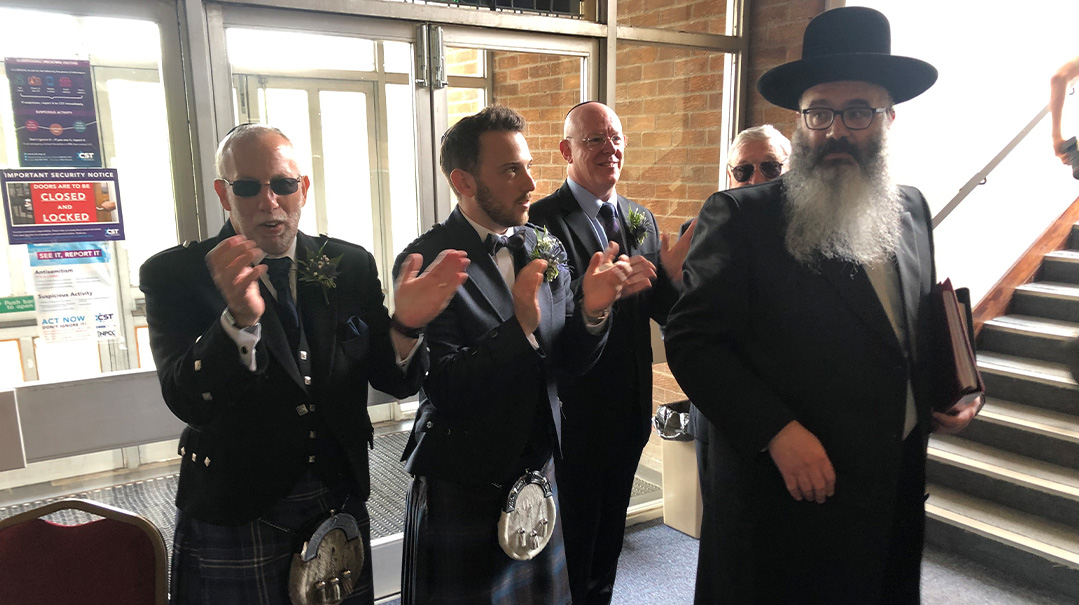
Rabbi Rubin celebrates with the chassan and his family, kilt-clad in their formal Scottish best.
A Kehillah Dwindles
Today there is limited Jewish education in Glasgow, just a state elementary school that has a majority of Jews, yet as a government institution, also takes in non-Jews. It offers a Jewish education that tries to impart a strong sense of Jewish identity and community.
We knew there must have once been more Torah study in this city because of the impressive collection of seforim in the beis medrash. It turns out that for almost 30 years, there was a real kollel in Glasgow with about 10 avreichim, and that’s what brought Brooklyn native and Gerrer chassid Rabbi Moshe Rubin to Glasgow shortly after his marriage. Today he’s the Giffnock Synagogue’s senior rabbi and, as the senior rabbi in all of Scotland, is often the face of Jewry for governmental and official issues.
Soon after his arrival, the community saw someone who was wise, kind, had a love of all Jews, was a great baal tefillah and baal korei, and had a rebbetzin to match. Rabbi Rubin had joined the kollel in 1989, became assistant rabbi in 1994, and rabbi in 1999. Rabbi Rubin and his wife Hadassah, together with their children, have been the royal rabbinic family of Scotland for nearly 25 years, representing the face of Judaism in the country. Whenever there is an official event or issue needing the Jewish voice or involvement, Rabbi Rubin is there.
Their older children learned in the “kollel school” that was run by rosh kollel Rabbi Mordechai Bamberger and his rebbetzin. After the kollel closed, and with it the school, the younger Rubin children were home-schooled. Only the two younger children are still at home — a daughter (who wrote an article for Mishpacha about their community during Covid) and the recently bar-mitzvahed son who now takes some of the leining privilege from his father. They are both highly involved in the shul with grace and self-confidence.
It’s always fun when you meet a neighbor while traveling. We came all the way to Glasgow to meet a fellow named Adam Bookman, who turned out to be a neighbor from Ramat Beit Shemesh. A Glasgow native, Adam and his brothers went to Manchester for high school on the advice of a local rabbi, and are now knowledgeable, frum members of their communities. Adam still returns to Glasgow for business and loves the warmth of his old community. He reminisced about the multitude of shuls, the kollel, the youth activities, kosher eateries, local shechitah, and even local chalav Yisrael – all of which have dwindled together with the population.
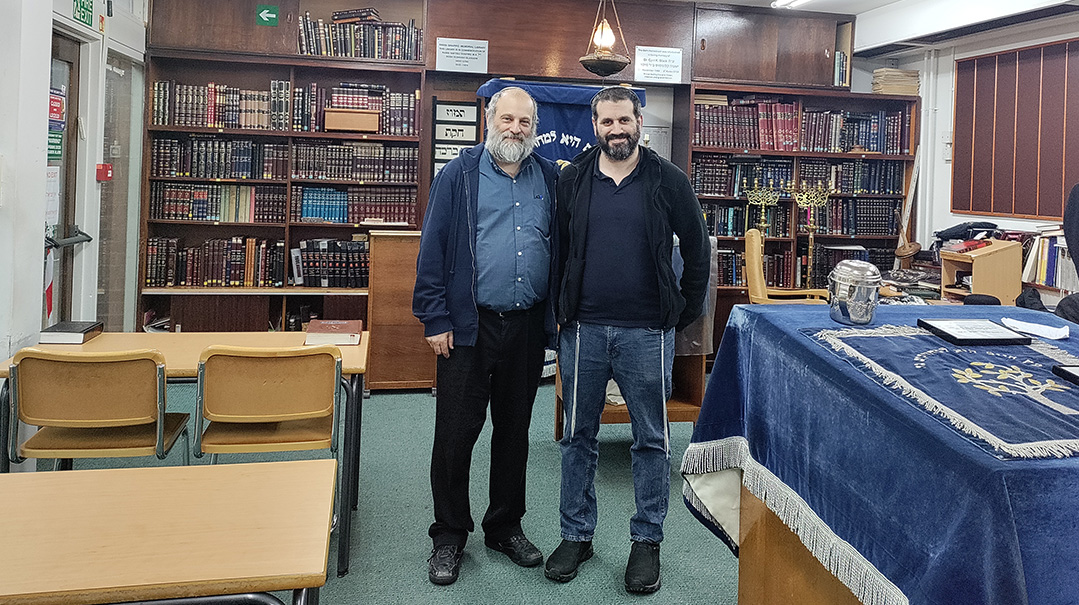
Rabbi Aharon Lemberger, a new address for young families and students
Shabbos Never Ends
We knew it would be a late Shabbos, and we were prepared – with Shabbos going out that week at 11:35 p.m. The community as a whole brings in Shabbos at plag haminchah, which was around 8:10 p.m. that week, thus presenting a narrow window in which to light candles, as one cannot light before plag and must light by the time the community accepts Shabbos, about 20 minutes later. Friday night, like weekday davening, was in the beis medrash, with Rabbi Rubin leading davening with his strong and melodious voice.
Shabbos morning davening at 9:30 was in the main sanctuary, a huge shul able to hold 750 people. That Shabbos was a special week, as the community was celebrating an aufruf of a local boy and an Australian girl, so the shul was more crowded than usual, with about 75 men and 30 women. With his wit and oratory skills, Rabbi Rubin involved everyone in the services and the sermon, and later, at the sit-down kiddush, he and Rebbetzin Hadassah went from table to table, sitting and shmoozing with their congregants. Having participated in the aufruf and accompanying kiddush and sensing the warmth of the community, we felt comfortable showing up Sunday morning to experience a Scottish chuppah in the shul. We were not disappointed: The elegantly-dressed women and the kilt-clad men created an atmosphere of real joy, and the tall, bearded Gerrer chassid in his beketshe standing next to the young chassan in his kilt and full Scottish outfit was a sight to remember.
Another couple we met, newly active in the Jewish community, are Rabbi Aharon and Hodaya Lemberger, both of them learned, talented and gracious. They arrived in Scotland three years ago with their three young children after training in the Straus-Amiel program in Jerusalem that trains rabbinic couples for shlichus to the Diaspora. Their role and goal are to work in the universities throughout Scotland, helping with Jewish awareness, education, and generally being in service of the Jewish students. Students come from all over the world for the high quality, inexpensive Scottish university education. But just as they were feeling the ground under them, Covid hit. Deemed “essential workers” during some of that difficult period, they were able to interface a bit with the students, providing counseling and educational services that were sorely needed and much appreciated. Now that things are pretty much back to normal, they’re busier than ever, building relationships with students, leading educational programs, and hosting students on Shabbos. Another couple is due to join them and will be stationed in Edinburgh, while the Lembergers will continue to focus on Glasgow, where they’ve already become an address for young families who want to connect to the Jewish community. Rabbi Lemberger is also the assistant rabbi to Rabbi Rubin, servicing the Newton Mearns Synagogue.
With such a long Shabbos, there was time for a leisurely shpatzir through Rouken Glen Park, a large suburban park right in the middle of the Jewish neighborhood with a waterfall, lake, and woodland paths; and after that, there was still time for a late nap, Minchah at 10 p.m., and Seudah Shlishis in the shul.

Edinburgh’s Rabbi David Rose still maintains regular Shabbos davening, shiurim and community-wide events, even as the kehillah has shrunk over the years
Beat the Clock
Due to its northern location, Glasgow’s swing in day length is particularly dramatic. At the end of June sunrise is as early as 4:30 a.m. and sunset as late as 10:05 p.m., with nightfall being as late as 11:40, and even later in the further northern communities. This obviously makes for a very late beginning and end of Shabbos, but it also has significance for all nightime mitzvos, such as Maariv and Krias Shema. On the flip side, in the winter, sunrise is as late as 8:45 a.m. and sunset as early as 3:45 p.m., leaving very limited daytime and thus raising questions about various day mitzvos, such as davening and putting on tefillin if it’s still dark.
Another natural phenomenon is that it’s cloudy a huge percentage of the time, with rain almost daily. Jokingly, we questioned how they say Tefillas Geshem with kavanah, but more seriously, we wondered if they had issues with Kiddush Levanah, for which the moon has to be seen. It reminded us of the question sent from India to the Ben Ish Chai about the problems they had during monsoon season when it is perpetually cloudy. Rabbi Rubin confirmed, however, that he’s never missed a month.
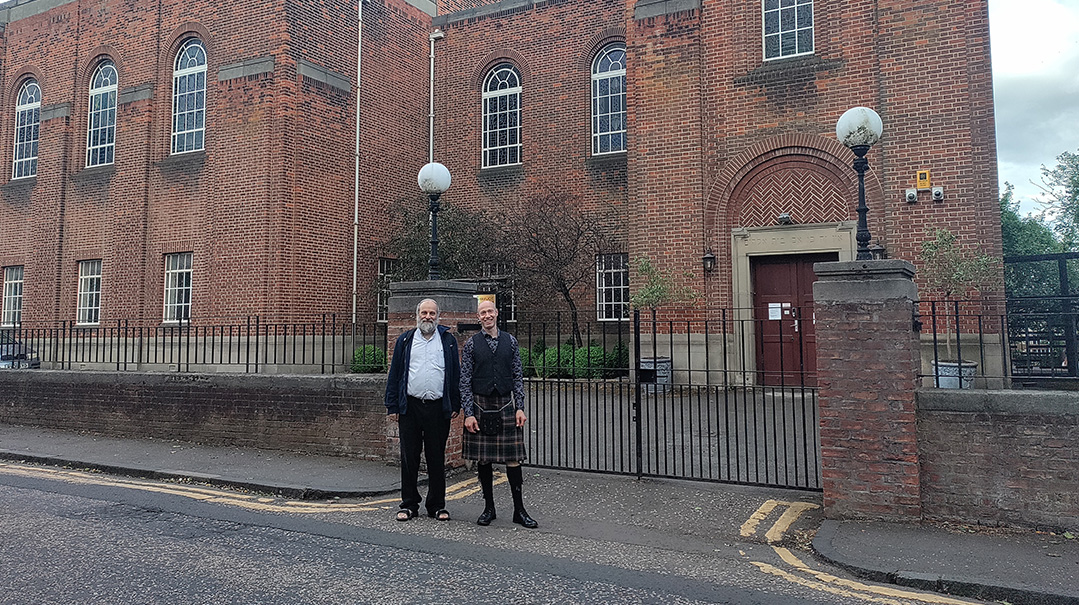
With our new friend who came to collect his kids from choir practice, after heading back from the queen’s garden party
All Dressed Up
Edinburgh, Scotland’s capital and official residence of the British monarchy in Scotland, is probably best known for the castle that overlooks its old city. The road connecting the castle with Holyrood Palace is known as the Royal Mile and is the busiest tourist street in the Old Town. Strolling along the Royal Mile, we began to notice people walking purposefully in one direction dressed in their holiday best. The women were wearing elegant heels and fancy hats, and the men were either in suits, military uniform or full traditional Scottish garb. The kilted skirt, whose pattern identifies which family the wearer is from, is only a part of the outfit. There are also special socks, a pouch called a sporran, a sgian-dubh, a small knife tucked into the socks, and traditional shoes known as brogues.
We stopped a couple walking in the direction of the palace and asked what was happening. They politely informed us that they were heading to the queen’s annual garden party at Holyrood Gardens at the end of the Royal Mile, and formal dress is required. Either the queen or senior royals are always present. (This summer, of course, the queen was quite weak and couldn’t make an appearance.) The party is not for the elite, but rather the invitations were sent to people involved in charitable activities. We stopped a few more groups of people heading to the party (as obvious by their dress) and learned about the range of their charitable and social involvements all over Scotland. One middle-aged gentleman, upon hearing that we were from Israel, volunteered that he was familiar with the Edinburgh shul, that it was a “small but important community,” and that there would certainly be a representative of the Jewish community at the party. Rabbi Rubin later told us he has been there twice.
Hard as we tried, we were unable to secure an invitation to the party at that late hour. So, we headed over to the Edinburgh Hebrew Congregation, the only functioning shul in Edinburgh, which has been in its current building since 1932. Rabbi David Rose, who has been rabbi of the community since 2003, graciously showed us around. The community admittedly has shrunk over the years, but it still has consistent Shabbos davening, shiurim, and large communal social events.
The main sanctuary used to have a very high ceiling and a balcony for the women’s section, but seeing how the kehillah was shrinking, they cleverly “raised the shul,” essentially separating the sanctuary into two vertical sections. The lower part, the original men’s section, became a social hall with a new ceiling, and the men and women are now both in the old balcony level, with the new women’s section slightly raised behind a mechitzah.
In true British form, the choir participates in the davening every Yom Tov, and the rabbi himself is a member of the choir. Dedicated as he is to his congregants, he ended our little tour when a few other choir members arrived for choir practice. It was a convivial group that included a retired doctor, an Israeli physicist who had been there for over 30 years, and a couple who had brought their grandchildren to the practice because their son and daughter-in-law were at the royal garden party.
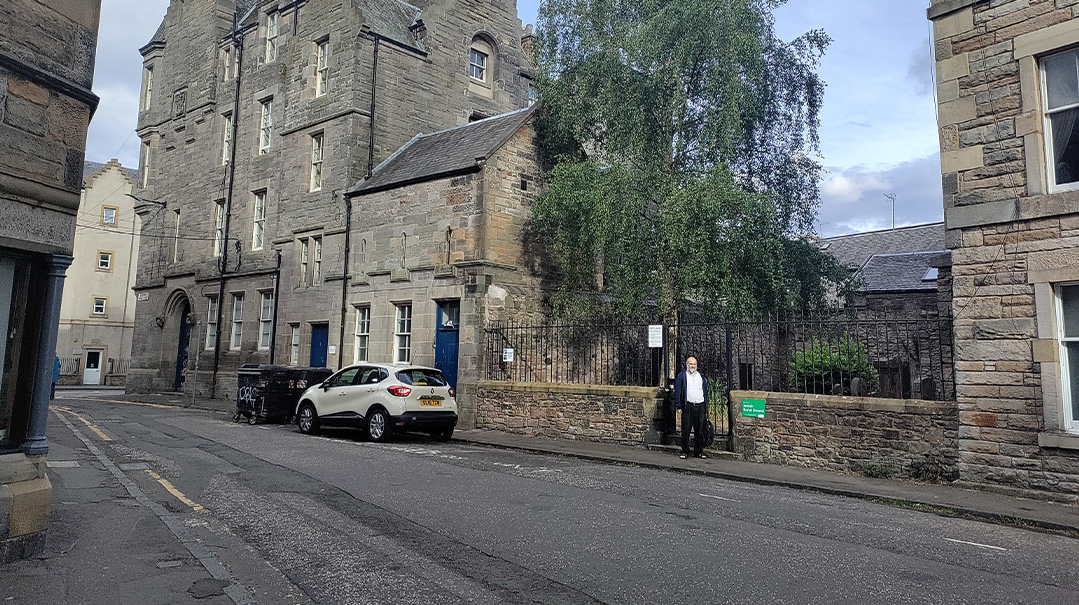
The Edinburgh Jewish cemetery is Scotland’s only stand-alone Jewish burial ground, located in what was once an outlying suburb but now smack in the middle of a residential neighborhood;
Buried Treasures
We left the shul headed in the direction of a small, older cemetery a few blocks away. Crossing the street (which we always did carefully as they drive on the “wrong” side of the road), a couple who had clearly noticed our yarmulkes asked if we knew where the “scheel” was. Turns out they were a Belgian Jewish couple on vacation who, like us, enjoys seeking out the Jewish sites. As we walked them back to the shul, we spotted a couple getting out of their car, dressed as if they had come for Yom Tov davening — or maybe from the garden party. Since the kilt-clad gentleman had a striking resemblance to the man who brought his grandchildren to the choir practice, we struck up a conversation like old friends, and he warmly shared with us his recollections of what was once a larger active community.
Just south of the Edinburgh city center is the district of Sciennes, once home to a young Arthur Conan Doyle, author of Sherlock Holmes. It’s also the site of the oldest and only stand-alone Jewish cemetery in Scotland. We walked the few blocks from the shul to the small, gated, well-kept graveyard situated smack in the middle of suburbia. When it was opened in 1816 it was a remote location. By the time of the final burial here in 1867 there were 29 graves. The Hebrew can still be made out on some of the tombstones.
Before the opening of this cemetery, the few Jews living in Scotland must have been buried somewhere, and we accidently stumbled across a story of one of those Jews. Heading up to see the magnificent views from the top of Calton Hill, we detoured into the Old Calton Burial Ground, a cemetery dating from 1718. Checking the Wikipedia entry, we were intrigued to read: “In 1795, Herman Lion [or Lyon], a Jewish dentist and chiropodist of German nationality who had moved to Scotland in 1788 and who could not be buried in a Christian graveyard, petitioned the Town Council of Edinburgh for a small piece of ground as a burial ground for himself and his family… The location of this burial ground is indicated on the 1852 Ordnance Survey map as ‘Jews’ Burial Vault (Lyons Family)’ just outside the north wall of William Henry Playfair’s City Observatory.”
We found out that although originally a chiropodist, he wrote a 400-page medical text that included his name in Hebrew, Chaim ben Leib. He had difficulty being recognized as a medical doctor in Scotland so he moved to Sweden, established himself as a dentist of note, and even treated the royal family. He eventually came back to Scotland, and although it’s hard to know how religious he was, we do know that in death he insisted on a Jewish burial. We thought of him, this lone Jew sticking to his traditions, as we looked all around the observatory but found no trace of his tomb.
We later discovered the reason we couldn’t find it: It turns out that he was buried in a still-intact though not easily accessible underground family mausoleum, which actually became the subject of a 2013 archeological investigation.
Back in Glasgow, we visited the “old Jewish cemetery,” which is a very small section in the huge Glasgow Necropolis. The first Jew buried in the necropolis was Joseph Levi, a quill maker who died of cholera in 1832, and the final Jewish burial there, the 57th, was in 1855. They included stillbirths, young children, and elderly. The small section was restored in 2015, but given the poor state of some of the tombstones and uncertainty of their proper location, Rabbi Rubin suggested placing the headstones on the perimeter and fencing off the area. It is now respectfully closed off, with the original gates and stone pillars that have both pesukim and quotes from Scottish poets engraved on them — giving a feeling that the old Jews of Scotland are still cared for.
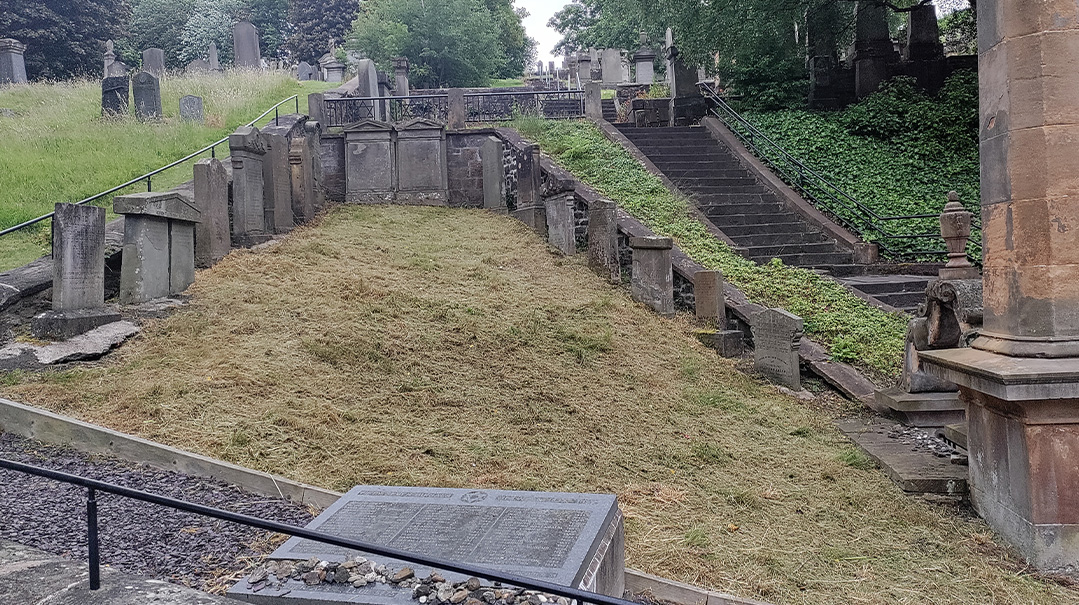
The small Jewish section of the massive Glasgow necropolis
Blessing for Nessie
There are currently no kosher restaurants in Scotland, but food was not a problem. Walking distance from the Giffnock Synagogue is Mark’s Deli, which is really more than a gastronomic resource. True, they do kosher catering, sell ready-made food, and kosher and Israeli products. But it’s also a focal point for the wider local Jewish community, where everyone seems to stop by on Friday for their challah and Shabbos treats and to meet up with friends, including the deli staff themselves, who were welcoming and helpful to us tourists as well.
We also enjoyed the kosher food prepared by Chabad’s L’Chaim catering. And in Edinburgh, we were impressed by the wide selection of food, including packaged meat, chopped liver, and of course British fish balls available in the “kosher section” of a large supermarket.
There is no shechitah in Scotland; their kosher meat comes from England, but it wasn’t always that way. In the late 19th century, Aberdeen, on the far northeast coast of Scotland, was a meat supplier to London and the Jews wanted in as well. A shul formed there in 1893 with a rabbi who was a shochet and shechitah commenced. Within a month of the first shechitah, the shochet and president were arrested, accused of violating the cruelty to animals act. As documented by Dr. Kenneth Collins, charges against the president were eventually tossed and the accusations against the shochet were found “not proven.” As the Aberdeen Journal noted on the day following the verdict, the case was “frivolous and vexatious,” and that real animal cruelty could be found in ordinary (i.e., non-kosher) slaughterhouses on any working day.
Aberdeen was not the only “wee” (a word that the Scots use for “small”) Jewish community in northern Scotland. Driving through the drizzly, cloudy, narrow roads of the hilly Scottish Highlands, one is awestruck by the raw, natural beauty. Sheep and cows graze in the fields on rolling hills, and bodies of water are an abundance with the many lochs (lakes). The highlands are gorgeous, and we first visited Loch Lomond, continuing up to the famous Loch Ness and there, while on a boat searching for “Nessie,” the Loch Ness monster, the question arose as to what brachah we’d make if we actually saw her. Alas, she never showed her face.
At the tip of Loch Ness is the town of Inverness, and it too once had a small community with a rabbi. It just reinforced what we’d already seen: the Scottish Jewish community, while proud and fully functioning, is certainly not what it once was. But what hasn’t lessened is the warmth of the community. The people are in direct contrast to the weather — the latter is always cool and drippy (although not as bad as its reputation), while the former is warm and welcoming, and hasn’t lost its royal feel.
(Originally featured in Mishpacha, Issue 928)
Oops! We could not locate your form.

